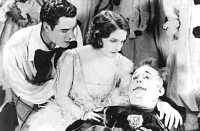Classic Movie Review: He Who Gets Slapped
By Stephanie Star Smith
May 17, 2004
BoxOfficeProphets.com

It's surprising how much we've come to rely on sound to keep our attention during a film, or perhaps more precisely, to assist us in keeping the narrative thread during those moments when the mind goes out to play in greener pastures. Watching a silent film requires more concentration and more dedication to keeping the mind on task, but the rewards for that effort are sufficiently great that anyone truly interested in film continues to try until the art of watching a silent has been learned.
Certainly one of the rewards for delving into the silent era is the opportunity to watch a true legend at work. In He Who Gets Slapped, that legend is Lon Chaney, Sr, the Man of a Thousand Faces, plying his art in this tale of humiliation, betrayal, revenge and redemption.
Chaney plays Paul Beaumont, an impoverished inventor on the verge of an important discovery. He has been lucky enough to receive the patronage of a baron, who has invited Beaumont and his wife to stay in his villa while Beaumont completes his work. Beaumont's work and his beloved wife are his entire world, but unfortunately for the poor man, his wife has eyes towards money, and the baron eyes towards stealing Beaumont's work and presenting it as his own. Which he does, while Beaumont watches in horror, having been tricked into believing the baron would simply introduce the discovery and then give proper credit where it was due. Beaumont, angry at the betrayal, verbally attacks the baron, who slaps him in order to keep Beaumont from possibly exposing the truth. The assembled crowd laughs, and after a bit, Beaumont bitterly laughs with them. Upon returning to the comfort of his own rooms and his beloved wife, looking for reassurance and steadfast affection, Beaumont discovers the further humiliation that his wife has chosen the baron's world of money and material things, and Beaumont realizes how it was the baron got hold of his work, and that his trust and love have been betrayed. Perhaps going slightly mad, Beaumont remembers the derisive laughter resulting from his earlier outburst, deciding to lose the man he was and transform himself into one who serves only to amuse others.
This is but the set-up to the majority of the film, which follows the fortunes of the clown known only as He Who Gets Slapped - shortened to He by colleagues - who nightly relives the humiliation of his former life for the delight of audiences around the world. As fate - and Hollywood - would have it, however, He once again finds himself unlucky in love, which indirectly brings into his path the man who so grievously wronged him. Given this opportunity by the gods, He finds within himself the strength to set right the course of true love whilst wreaking vengeance on not only his own betrayer, but those who would barter another human's heart as though it were a commodity.
So what could possibly entice a modern film lover to sit down for this black-and-white silent melodrama?
The main attraction, of course, is Lon Chaney. Chaney was perfectly suited to silents; he was born with a face that was very facile in conveying emotions. Just as with films today, a great deal of acting in the silent era was done with the eyes and the facial expressions, and although the style was a bit more flamboyant, the aim was still to impart to the audience what the character was thinking and feeling; the actor was simply unaided - or unencumbered, if you prefer - by words. Chaney excelled at displaying the most complex of emotions with a gesture, a glance, a certain way of moving. And it wasn't just his face that he employed; Lon Chaney had the most expressive hands of nearly any actor I've ever seen. To watch this amazing man play a scene is to be astounded by the depth of his skills, and by how affecting the emotional impact is. All without words to tell the audience exactly what was happening.
Another reason is the film tells a good story. Actually, most of the silent films that survive to this day have done so because, silent though they may be, the story is compelling and timeless. The struggle to do good, to be loved, to make a living in a difficult world, to learn how to go on when all has seemingly been lost; these are timeless themes, and they are the focus of any good story, whether it be on stage, page or screen, silent or with sound, black-and-white or glorious Technicolor. And as was often the case with Chaney's work, the role he plays is a tragic figure, but one who by the film's end has found what measure of happiness is available to all of us in this life, and is at peace with himself.
But mostly, He Who Gets Slapped is a great film, and makes for a pleasurable viewing experience for anyone willing to invest the just-over-90 minutes of its running time. Such a great reward for such a small expenditure in time and attention is certainly not a treasure that should be ignored by any lover of cinema.